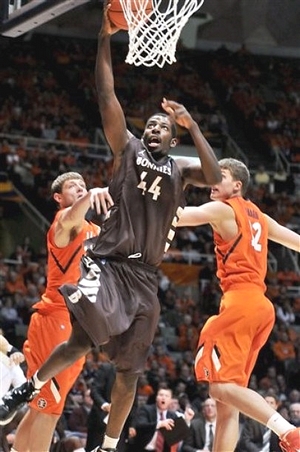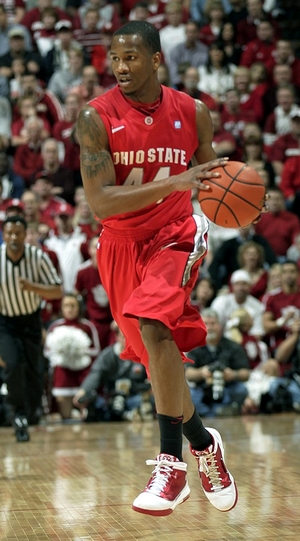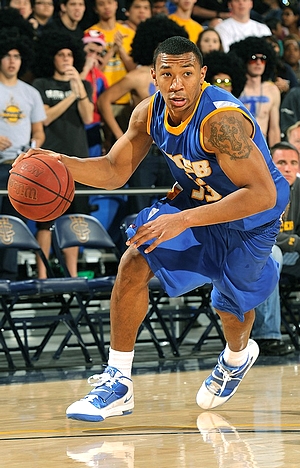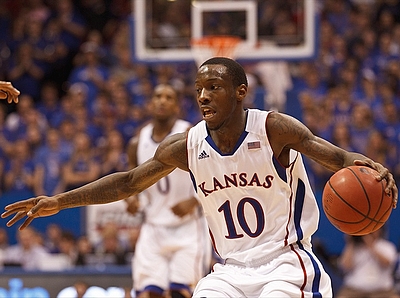-Trending Prospects (12/9) - Doug McDermott, Scott Machado, Henry Sims
-Trending Prospects (12/22) - Kris Joseph, Draymond Green, Chace Stanback
-Trending Prospects (12/23) - Will Barton, LeBryan Nash and Ricardo Ratliffe
-Trending Prospects (12/30) - Mike Moser, Kenny Boynton and Jarrod Jones
-Trending Prospects (1/6) - Herb Pope, Eric Griffin, Otto Porter, Quincy Acy
-Trending Prospects (1/12) - Arnett Moultrie, Kevin Jones, Robbie Hummel, Elias Harris
Andrew Nicholson, 6'9, Senior, PF, St. Bonaventure

Derek Bodner
After an impressive junior season that saw Andrew Nicholson average 24.4 points per-40 minutes pace adjusted and emerge as one of the most versatile scoring big men in college basketball, he has struggled to take the next step as an all-around prospect individually, and has been unable to help his St. Bonaventure team get over the hump in the Atlantic-10 as well. 16 games into the season, Nicholson has seen his production drop to 21.5 points-per-40 pace adjusted while his true shooting percentage has dropped substantially, from 57.1% to 51.7%.
Nevertheless, standing 6'9 with excellent length and big hands, Nicholson has some intriguing aspects of his game, both in terms of his physical profile and from a skills perspectiveand is almost certainly not a finished product yet.
Offensively, Nicholson relies heavily on a very refined post game that's tough to defend at this level, particularly when paired with the improving perimeter game he showed last year. With good footwork, counter moves, and an ability to finish with either hand, Nicholson has plenty of moves in the low post. According to Synergy Sports Technology, Nicholson is shooting 54% in post-up situations, while doing a solid job of drawing contact and getting to the line.
Turnovers tend to be a problem for Nicholson, and his 3.8 turnovers per 40 minutes pace adjusted is one of the worst numbers in our top 100 ranking. This is especially troubling considering how infrequently he creates for his teammates, with a pure passer rating of -7.97, which is the worst in our top 100.
The overall talent level at St. Bonaventure leaves a lot to be desired, and as such he's probably asked to create more for himself than he optimally would. Despite that, he doesn't do a very good job of recognizing double teams and could continue to improve his ball-handling and decision making skills.
On the perimeter is where Nicholson differentiates himself from other big men prospects in this draft in terms of his talent-level. While not an exceptional athlete at the NBA level, Nicholson is a fluid and mobile big man with a long first step and an intriguing skill-level that gives him the ability to make very impressive plays at times. Although he's not terribly polished or consistent at this point in his career, his ability to face up opponents off the dribble, pull-up off the dribble from the mid-range or take the ball all the way to the basket and finish with his length is very impressive at his size.
Nicholson did a good job last year of extending his range out to mid-range, something he didn't have prior to his junior season. While he's attempting more 3-pointers this season, he hasn't taken a major step forward with this part of his game, only converting 35% of his jumpers, down from 45% last year. He has decent form on his jump shot and a high release, but hasn't been able to get these shots to fall consistently this year.
With his slight build it appears likely his post-up game will be less of a weapon in the NBA, so having a consistent catch and shoot game will play a crucial part in his ability to carve out a role for himself.
On the offensive glass, Nicholson's 3.1 offensive rebounds per 40 minutes pace adjusted is significantly better than the 2.0 per 40 minutes pace adjusted he averaged last year, but still towards the lower part of our database in terms of power forward prospects. Nicholson isn't all that physical of a player, nor is he all that active in fighting for position for offensive rebounds, leading many to question his toughness as a prospect. When he does grab an offensive rebound, he has solid touch and converts them at a decent clip.
From a defensive standpoint, Nicholson's physical profile presents some potential problems, which are further increased by his inconsistent effort on that end of the court. Nicholson has the length and timing needed to contest and block shots, and because of that can be a useful defender at the collegiate level. At a wiry 220 pounds, he lacks the lower and upper body strength to hold his ground at the next level, and he doesn't do a good job of fighting for position early in the shot clock to make up for that. Again, showing more of a mean streak would greatly benefit him in this regard, but that simply does not appear to be his disposition.
On the perimeter, Nicholson doesn't move all that well laterally, being very upright in his stance and showing average quickness and fundamentals. He compensates this on pick and rolls by giving a copious amount of room to the ball handler on pick and rolls, something that will likely be exploited at the next level, where he'll be forced to guard NBA power forwards as opposed to collegiate centers.
On the defensive glass, his 6.7 defensive rebounds per 40 minutes pace adjusted are in the middle of the pack in our rankings. His length helps him in this regard, but he doesn't show great anticipation or technique, and he once again doesn't appear to consistently put in the effort or have the toughness to dominate that facet of the game. Perhaps more than anything this is the part of his game that may be hard to overcome and get playing time, particularly early in his career while he tries to adjust his post game to NBA defenders.
Andrew Nicholson has an interesting set of physical tools with his size and length to go along with an offensive skill-set that shows plenty of room for growth. On top of that, he appears to be an extremely intelligent person off the court (he's a physics major), and didn't start playing basketball until his junior year of high school.
Nicholson came into this season with huge expectations, both individually and team-wise, but hasn't taken the step forward some had hoped he would. NBA decision makers will need to figure out why in trying to evaluate how much better he could become in the next few years, to decide if he's a project worth investing in.
William Buford, 6'6, Shooting Guard, Senior, Ohio State

Kyle Nelson
Not much has changed since we last wrote about William Buford, but he has nonetheless established himself as one of the top senior prospects in the country and an essential element of an outstanding Ohio State team. Buford is the only prospect ranked in the top-17 of the 2008 RSCI still playing college basketball, and is thus a fairly well known commodity as far as NBA scouts are concerned.
Measured at 6'5 with a 6'10 wingspan and a solid 209-pound frame, Buford definitely looks the part of a NBA wing player. Though he has improved his frame considerably since his junior season, he remains just an average athlete by NBA standards in terms of his first step, overall quickness and the explosiveness he displays around the basket.
While Buford's skill set remains largely the same as what we described in our previous report, his role in Ohio State's offense has changed. He's being asked to handle the ball in transition and act as more of a facilitator than he was in years past, which has increased his usage, but hurting his efficiency in the process.
Much of this drop in production has to do with his shooting woes outside of the arc he's converting just 36.4% of his 3-point attempts as a senior as opposed to 44.2% as a junioras in the absence of Jon Diebler and David Lighty he hasn't had as many open looks spotting up outside the arc. According to Synergy Sports Technology, he's taking more shots this year with a hand in his face than he did last season, and knocking them down at a much lower rate. He's also not making his open looks at quite the same rate, even if he still has plenty of time to revert to the mean as the season moves on.
His shooting mechanics, for the most part, are excellent, despite his lack of elevation and a somewhat slow release, but he has struggled mightily to convert them consistently. His worst shooting nights have come against teams with excellent perimeter defenders, as the likes of Victor Oladipo, Brandon Paul, Travis Releford and others have been able to key in on him far more than they were probably able to last season.
Buford's struggles creating efficient offense have validated the concerns about his average athletic ability and his likelihood of becoming a shooting specialist at best at the NBA level. With that said, it is wise to consider his body of work when evaluating his perimeter shooting ability, as other players have shown in the past that it's not uncommon for a player's efficiency to decrease with a more pronounced role.
Getting his jumper back on track is essential for Buford because of his lack of ideal physical tools and shot-creating ability, which seemingly limit his potential to contribute heavily in other areas in the NBA. Though he has developed his mid-range repertoire steadily at Ohio State and can find other ways to put the ball in the basket thanks to his excellent scoring instincts, the question remains of whether he can continue to improve and adapt to better defenders at the next level.
Despite his struggles as a senior, Buford continues to project favorably as a NBA role player, something he's already proven to be capable of at the college level on a number of very successful teams. He's averaging a career high 4.2 assists per 40 minutes pace adjusted this season, which is near the top amongst true shooting guard prospects in our database.
In addition, his size, length and excellent fundamentals give him a very good framework of skills to build off on the defensive end, even if he does not possess elite lateral quickness. Buford has good fundamentals and awareness on defense that somewhat obscure his physical deficiencies. Simply put, he is a good team defender on the NCAA's best defensive team. It's safe to say he will be able to at least hold his own on that end of the floor in the NBA.
While Buford possesses the intangibles to positively impact team chemistry and is one of the best scorers in Ohio State history, he must continue to produce efficiently as the season moves on to prove his mettle as a valuable NBA rotation player. If Buford can prove that his shooting struggles are a blip on the radar, which his career trajectory suggests is the case, then there is little doubt that he can carve out a role in the NBA.
Orlando Johnson, 6'5, Senior, Shooting Guard, UC Santa Barbara

Matt Williams
When we last checked in on Orlando Johnson, we noted that the development of his ball-handling ability and the improvement of his shot selection would play a big part in his growth as a prospect after he jumped onto the radar last season. After spending the summer polishing his game against other potential draftees at the LeBron James Skills Academy and competing for Team USA at the World University Games after withdrawing from the 2011 NBA Draft, Johnson is having another strong season, though his role has changed more than his game.
The California native is scoring marginally less and shooting 4% worse from the field and 14% worse from the line than he did last season, but he has seamlessly taken on new responsibilities in Santa Barbara's offense. Arguably the deadliest scorer in low-major hoops, Johnson has become the focal point of nearly everything Santa Barbara does on that end of the floor. After spending most of his time getting up the floor on the wings and working in isolation sets last year, the senior has brought the ball up the floor at times and has seen his per-game usage on the pick and roll and in the post double this year according to Synergy Sports Technology.
Despite the shift in his role, Johnson has continued to produce at a high level, especially against better competition. Averaging 23.4 points and 8.0 rebounds in UCSB's games against San Diego State, Washington, BYU, Cal, and UNLV, Johnson has alleviated many of the concerns scouts usually have about small conference prospects with his play against the Gaucho's high-major non-conference opponents.
Still the same potent wing scorer who relies heavily on his ability to take and make difficult shots, Johnson has developed into a threat to score from almost anywhere on the floor thanks to his terrific range, unwavering confidence, and ability to create just enough room to get his shot off in the college game.
Johnson's half-court shots came from a near equal amount of catch and shoot and pull-up jumpers last season. This season, he's taken nearly five times more pull-up jumpers than with his feet set. Garnering attention for his prolific spot-up shooting in 2011, Johnson has had to create for himself far more regularly in the midrange a venture that yields mixed results at times.
Regardless of how much time he is spending on or off the ball, Johnson is still hitting his 3-pointers at a solid 41% clip this season, identical to last year. The difference has come inside the arc, where his percentages have dropped from a rock sold 51% last season to a far less impressive 44% this year.
Around the basket, Johnson's strong frame and touch make him a threat to take advantage of smaller wings in the post and finish in the paint when he finds an opening at the college level. With that said, his inability to create separation with his first step and lack of dynamic ball handling ability raises concerns about whether he'll be able to score efficiently inside the arc NBA, let alone make an impact around the basket.
Given that his weaknesses limit his upside at the next level, Johnson's experience handling the ball more regularly, dealing with the double teams he sees on the pick and roll, and passing out of them can be looked at as positives. Considering how little he turns the ball over for a player in his role, Johnson could fit into a spot-up oriented role if he can tone down his shot selection, ramp up his efficiency and fill a niche as a complimentary scorer.
On the defensive end, Johnson has been able to compensate for his average footspeed with his 7'0 wingspan as UCSB has moved away from its zone schemes for longer stretches. Using his length to effectively contest shots at the collegiate level, Johnson will need to show that he can deny penetration against NBA caliber athletes to remove questions about his defensive upside, something he's seen mixed results with this season.
UC Santa Barbara will face a tough path to return to the NCAA Tournament with the emergence of Long Beach State as a potential Big West contender, and their ability to make a postseason run will fall squarely on Johnson's shoulders. While his role is less reflective of where he seems to fit best at the NBA level than it was last year, Johnson's scoring instincts and productivity still have him firmly on the NBA radar. If he can showcase his spot-up shooting in workouts, and become a more consistent defensive player, Johnson could see his stock climb as we head towards the 2012 draft.
Tyshawn Taylor, 6-3, Point Guard, Senior, Kansas

Walker Beeken
Tyshawn Taylor has taken on a larger role in his final season at Kansas, and he's been instrumental in the Jayhawks getting off to an impressive 15-3 start, including winning their first five games in conference play, despite an inexperienced roster. The senior point guard is leading the team in minutes and assists per game and is also their second leading scorer, behind All American candidate Thomas Robinson.
As we've written before, Taylor has always been an impressive prospect from a physical standpoint. Standing 6'3 with a lean frame, he has a solid first step, very good top speed with the ball in hands, and nice lateral quickness defensively.
These traits put him on the NBA radar early in his college career, but his lack of consistent production and a number of off-court incidents have prevented him from becoming more of a highly regarded prospect.
The strides he's made this season may have him headed in the right direction, but he still has a glaring weakness, with his poor decision-making skills. Taylor is still coughing the ball up as much as ever, with a turnover on a quarter of his possessions so far this season. While there are other high profile point guards turning the ball over at a higher rate, Taylor's heavy usage puts him in the spotlight, as does the fact that he's had some of his high turnover games against good teams, such as 11 in the Duke game, 7 against Ohio State, and 8 in a rivalry game against Kansas State.
NBA teams may have concerns regarding whether he'll ever be able to run a team as a point guard and play efficient basketball, as he hasn't seemed to improve in that area much at all over the course of his time at Kansas.
Taylor uses almost a quarter of his possessions as the ball-handler on pick-and-roll situations, something he'd likely do just as much if not more at the NBA level. While he has the tools to be very effective in these sets, with his ability to pull up for the outside jump shot, and his burst to turn the corner to get into the paint, he's still far less efficient than scouts would like to see. He doesn't see the floor well once he's in attack mode, and he often over-penetrates and ends up throwing a bad pass or forcing up a difficult floater or shot attempt at the rim, as evidenced by his poor 39% shooting on attempts in the basket area so far this season, or his 45% 2-point conversion rate.
With that said, Taylor also makes some extremely impressive plays displaying his high talent level, whether it be splitting the defenders with the dribble to get in the lane, pulling up for smooth mid-range jumpers, or getting all the way to the rim and scoring with an acrobatic finish.
Perhaps Taylor's biggest improvement as a player over his time at Kansas has been with his shooting ability. He's knocking down a career-high 42% from 3-point range, despite the fact that he's nearly doubled his attempts from last season. He gets good elevation on his shot, has shown NBA 3-point range, and he's just as effective shooting off the catch with his feet set or off the dribble, both of which he does prolifically.
Defensively, as we've mentioned before, Taylor has all of the tools to successfully defend the point guard position at the NBA level. He has the size and lateral quickness scouts like to see, and he competes hard and generally shows good toughness as most Bill Self coached players do.
After biding his time as a role player on deep, loaded Jayhawk squads for three seasons, Taylor finally has his opportunity show more his overall game this season, and so far the results have been inconsistent.
It's been impressive to see his scoring and creating ability with his larger offensive responsibilities, but he still hasn't alleviated any of the concerns scouts likely have regarding his ability to take care of the ball and efficiently run a team from the point guard spot.
He does have his team exceeding expectations, though, and he has been a big part of that. If he can put together a strong second half of the season playing at a high level more consistently, particularly in the NCAA tournament, he'll have an opportunity to move up draft boards quickly.




































Comments